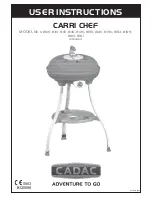
ENGLISH • 11
may present a risk of personal injury and/or damage
to property.
Safety of others
f
This appliance is not intended for use by persons
(including children) with reduced physical, sensory
or mental capabilities, or lack of experience and
knowledge, unless they have been given supervision
or instruction concerning use of the appliance by a
person responsible for their safety.
f
Children should be supervised to ensure that they do
not play with the appliance.
Residual risks
Additional residual risks may arise when using the
tool which may not be included in the enclosed safety
warnings. These risks can arise from misuse, prolonged
use etc.
Even with the application of the relevant safety regulations
and the implementation of safety devices, certain residual
risks can not be avoided. These include:
f
Injuries caused by touching any rotating/moving parts.
f
Injuries caused when changing any parts, blades or
accessories.
f
Injuries caused by prolonged use of a tool. When
using any tool for prolonged periods ensure you take
regular breaks.
f
Impairment of hearing.
f
Health hazards caused by breathing dust developed
when using your tool (example:- working with wood,
especially oak, beech and MDF.)
ADDITIONAL SAFETY INSTRUCTIONS FOR
BATTERIES AND CHARGERS
Batteries
f
Never attempt to open for any reason.
f
Do not expose the battery to water.
f
Do not store in locations where the temperature may
exceed 40 °C.
f
Charge only at ambient temperatures between 10 °C
and 40 °C.
f
Charge only using the charger provided with the tool.
f
When disposing of batteries, follow the instructions
given in the section “Protecting the environment”.
Do not attempt to charge damaged batteries.
Chargers
f
Use your Stanley charger only to charge the battery in
the tool with which it was supplied. Other batteries
could burst, causing personal injury and damage.
f
Never attempt to charge non-rechargeable batteries.
f
Have defective cords replaced immediately.
f
Do not expose the charger to water.
f
Do not open the charger.
f
Do not probe the charger.
ASSEMBLY
Warning! Before assembly, remove the battery from
the tool.
Fitting and removing the battery (Fig D)
f
To fit battery (5), line it up with the receptacle on the
tool. Slide the battery into the receptacle and push
until the battery snaps into place.
f
To remove the battery, push the release buttons (12)
while at the same time pulling the battery out of the
receptacle.
Fitting and removing a drill bit or screwdriver bit
(Fig. E)
This tool is fitted with a keyless chuck to allow for an easy
exchange of bits.
f
Lock the tool by setting the forward/reverse slider (2)
to the centre position.
f
Grasp the chuck (3) and rotate it in the counter
clockwise direction, as viewed from the chuck end.
f
Insert the bit shaft (13) into the chuck.
f
Firmly tighten the chuck by rotating it in the clockwise
direction as viewed from the chuck end.
Warning! Do not attempt to tighten drill bits (or any
other accessory) by gripping the front part of the chuck and
turning the tool on. Damage to the chuck and personal injury
may occur when changing accessories in this manner.
USE
Warning! Let the tool work at its own pace. Do not
overload.
Charging the battery (Fig. B)
The battery needs to be charged before first use and
whenever it fails to produce sufficient power on jobs that
were easily done before. The battery may become warm
while charging; this is normal and does not indicate a
problem.
Warning! Do not charge the battery at ambient
temperatures below 10°C or above 40°C. Recommended
charging temperature: approx. 24°C.
Note: The charger will not charge a battery if the cell
temperature is below approximately 10°C or above
40°C. The battery should be left in the charger and the
charger will begin to charge automatically when the
cell tempera- ture warms up or cools down.
f
To charge the battery (5), insert it into the charger (10).
The battery will only fit into the charger in one way. Do
not force. Be sure that the battery is fully seated in the
charger.
f
Plug in the charger and switch on at the mains.
The charging indicator (11) will flash green
continuously (slowly)
































